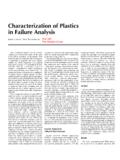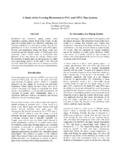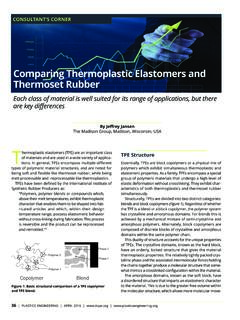Transcription of Plastic Failure Through Molecular Degradation - …
1 CONSULTANT S CORNERP lastic Failure Through Molecular DegradationMultiple mechanisms can attack polymer chains here s what can go wrongBy Jeffrey Jansenthe Madison group, Madison, Wisconsin, Usa[Note: The author will be presenting theSPE webinar Degradation Failure of Plas-tics on Feb. 18; see more details nearthe end of the article in the sidebar. Ed.] Molecular Degradation is aleading cause of Plastic com-ponent Failure , with a studyindicating that 17% of Plastic failuresare associated with a generic terms, molec-ular Degradation of a Plastic is thedeleterious alteration of the molecularstructure within the polymer as theresult of a chemical reaction. impor-tantly, Degradation mechanismsprincipally involve a permanent reduc-tion in Molecular weight as a result ofthe chemical reaction.
2 There arenumerous Molecular degradationmechanisms, but the most commonare: thermal oxidation, ultraviolet radiation, chain scission, and ofDegradationthe dominant mechanism of molec-ular Degradation and the extent ofdegradation are dependent on thecomposition of the Plastic resin andthe surrounding environmental con-ditions. significant property reductioncan occur within most polymer familiesas a result of Molecular forms of Degradation represent34| plastics EnginEEring | JanUarY 2015 | | 1: This nylon water-heater valve degraded Through contact with chlorinatedwater at elevated Consultants Corner_046854 12/16/14 8:15 AM Page 34chemical reactions that result in molec-ular structural changes that areaccompanied by noted decreases inphysical properties.
3 The reduction inmolecular weight associated withdegradation inherently leads to lowerductility due to the accompanying lossof entanglement of the now shortenedpolymer chains. This reduces the energy required for disentanglement/slippage to occur and shifts the pre-ferred mechanism from ductile yieldingto brittle fracture. The manifestations of moleculardegradation can include: loss of mechanical properties, like reduction in strength, embrittlement, cracking, and catastrophic Failure ; reduction in chemical resistance; aesthetic changes, like discoloration, chalking, loss of gloss, and clouding/loss of transparency; evolution of volatiles (includingfoul odor generation); and carbonyl formation (and loss ofdielectric properties).
4 Molecular Degradation can occurthroughout the lifecycle of a plasticcomponent. Regardless of when thedegradation occurs, the effects canlead to premature Failure of the com-ponent. (An example of a Failure isshown in Figure 1, and some typicalcircumstances are listed in Table 1.)Thermal oxidationThermal oxidation is the degradationof a polymeric material Through con-tact with a chemical oxidizer. Mostpolymers are subject to oxidation, andit is the most common form of plasticdegradation (consider Table 2).Oxidation is a chemical reaction inwhich oxygen is introduced into themolecular structure of the polymer,creating a form of carbon-oxygenbonds known as carbonyl produces a permanent change withinthe Plastic , most often in the form ofmolecular weight reduction throughshortening of the polymer chains.
5 Oxi-dation takes place via a multi-stepreaction based on free radical forma-tion. Free radicals can be found withinplastic formulations as unintentionalresidual byproducts of polymerization,as formulation additives, or as con-taminants. These free radicals reactwith oxygen to attack the polymerbackbone covalent most cases, the rate of the degra-dation mechanism will accelerate withtime as the reaction proceeds to auto-catalyze. Through thermal oxidation,the polymer chains are cleaved, andthe resulting shortened chains are ter-minated with oxygenated | | JANUARY 2015 | plastics ENgINEERINg | 35 Table 2: Inherent Resistance to Oxidation of Various PolymersTable 1: Circumstances Leading to Premature FailureLife Cycle StageConditionResultCompoundingExposure to elevated Chain scissionshear-induced heating while additives are incorporated into compound DryingExposure to elevated temperature Thermal oxidationfor an extended period of time while in the drying hopperProcessingInsufficient drying of resin prior Hydrolysisto injection molding leading to exposure to water at elevated temperaturesProcessingResin remains in the injection Chain scissionmolding barrel for a prolonged period of time at temperature beyond recommendedStorageOutdoor exposure to sunlight of Photo-oxidationnon-stabilized polymeric componentsInstallationUncontrolled elevated Thermal oxidationtemperatures used for welding
6 OperationsServiceParts exposed to fluorescent Photo-oxidationlightingServiceExposure to temperatures higher Thermal oxidationthan anticipated for extended periodsServiceContact with aggressive acidic or Hydrolysisbasic cleaning chemical agentsPolypropyleneLeast ResistantLow Density PolyethyleneHigh Density PolyethyleneNylonPolyacetalPoly(phenylen e oxide)Poly(ether ether ketone)Poly(phenylene sulfide)Poly(vinylidene fluoride)PolytetrafluoroethyleneMost Resistant34-39 Consultants Corner_046854 12/16/14 8:15 AM Page 35groups, including carboxylic acids,esters, ketones, and , commonly referredto as ultraviolet (UV) Degradation , isthe Degradation of a polymeric mate-rial Through exposure to terrestriallight energy in conjunction with contactwith a chemical oxidizer, such as upon their structure and thefunctional groups comprising the poly-mer, some plastics are inherentlysusceptible to photo-oxidation.
7 Givenenough light energy input, these sus-ceptible functional groups, known aschromophores, cleave to produce Through photo-oxida-tion is very similar to the thermaloxidation, and is driven by the pro-duction of free radicals. Essentially,the exposure to light energy results inthe accelerated formation of free rad-icals, which speeds the initiation ofthe Degradation reaction. Photo-oxi-dation is a chemical reaction facilitatingthe incorporation of oxygen into thebackbone structure as carbonylgroups, resulting in Molecular weightreduction of the energy at short wavelengths ismost severe toward polymeric mate-rials, and can break the covalentmolecular bonds forming the polymerbackbone. the shortest UV wave-lengths found within the Earth satmosphere are sufficient to producethis Degradation .
8 Most often, the chro-mophore that is susceptible to the UVenergy is a functional group within thepolymer; however, it can also be asso-ciated with an additive within theformulation. Bonds susceptible to pho-to-oxidation include carbon-nitrogenbonds such as nitrile, amide, andamine; carbon-oxygen bonds such asether, ester, ketone, and carboxylicacid; carbon-chlorine bonds; oxygen-oxygen bonds such as peroxide; andnitrogen-hydrogen such as amide damage is generallylimited to the surface layer exposedto the UV radiation, to a depth ofapproximately 150 m. the depth ofthe Degradation penetration is deter-mined by the extent of oxygendiffusion into the material. However,even damage to this minimal degreecan produce a deleterious radiation exposure degrades thepolymeric material, which results in abrittle surface layer.
9 This degradedlayer is then subject to localized shrink-age, producing stresses, or the directapplication of stress in the stress, and the accompanyingstrain, makes the material more proneto further oxidation and results in theinitiation of cracks within the surfacelayer. the cracking subsequentlyextends into the base material throughbrittle scission chain scission is the Degradation of apolymeric material in the absence ofa chemical agent, in particular withoutoxygen. as part of chain scission, themolecular structure of the polymer isaltered solely based on energy, poten-tially as exposure to high levels ofstress or elevated temperature. thecovalent bonds forming the polymerbackbone will break down randomly,resulting in rapid decreases in molec-ular thermal oxidation, chain scissionproceeds via a free radical the polymer backbone chains arebroken, carbon-carbon double bonds,known as unsaturation, are absence of oxygen drives thisdegradation mechanism.
10 Normally,chain scission is caused by exposureto elevated temperatures in combina-tion with high shear stress, and is oftenassociated with processing techniqueswhere air is not present. HydrolysisHydrolysis is the Degradation of a poly-meric material Through contact withwater, specifically the hydrogen cations(H+) or hydroxyl anions (OH-). Hydrolyt-ic Degradation can occur within plasticmaterials as a result of submersion inwater, progression Through conden-sation cycles, or by exposure to can also result from contact withacids (high H+concentration) or bases(high OH- concentration), which candramatically accelerate the polymers are inherently sus-ceptible to hydrolysis, given theirmolecular structure. specifically, con-densation polymers, such as thoselisted below, form water during thepolymerization process, and as such are susceptible to hydrolyticdegradation: polyesters (like poly(butyleneterephthalate), poly(ethyleneterephthalate), and copolyesterresins); polycarbonate; nylons (nylon 6, nylon 6/6, nylon12); polyurethane (ether-based andester-based); and polyacetal (homopolymers andcopolymers).









